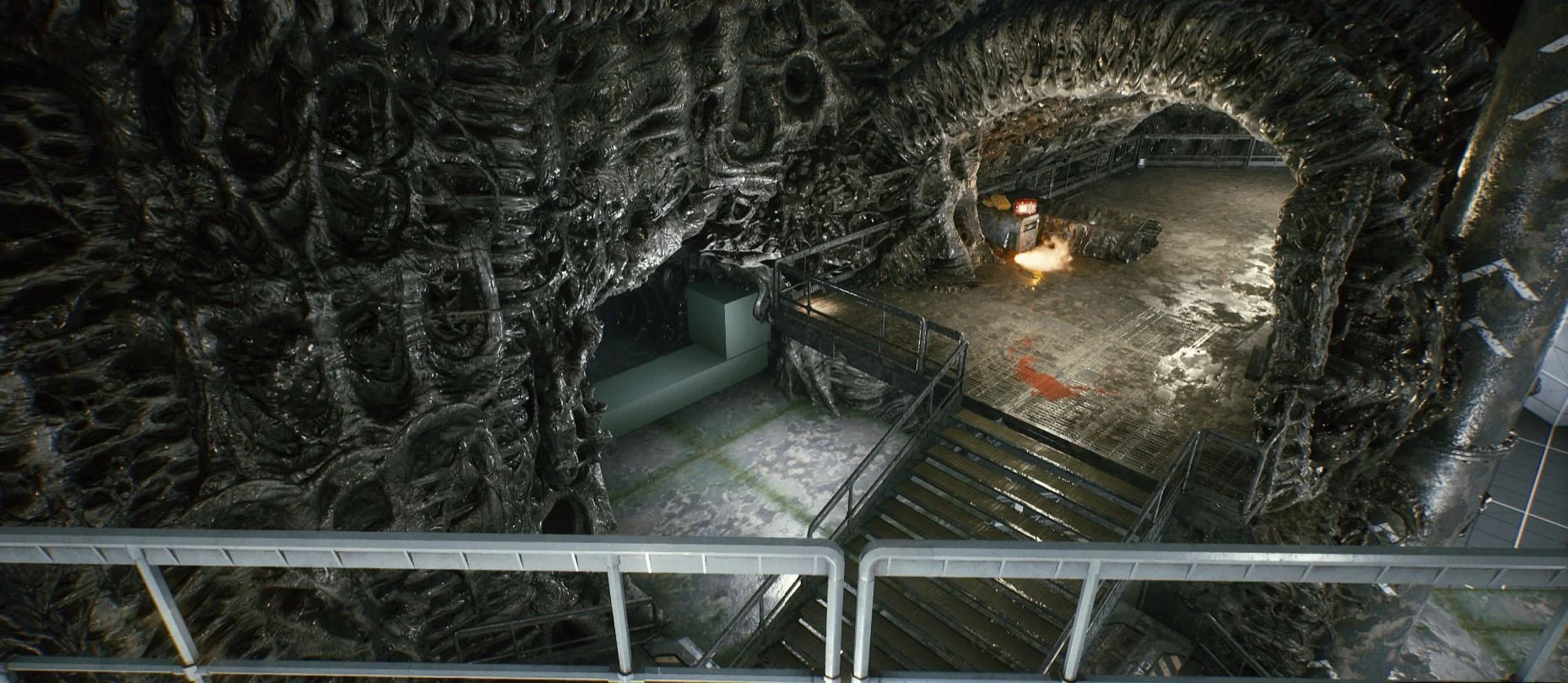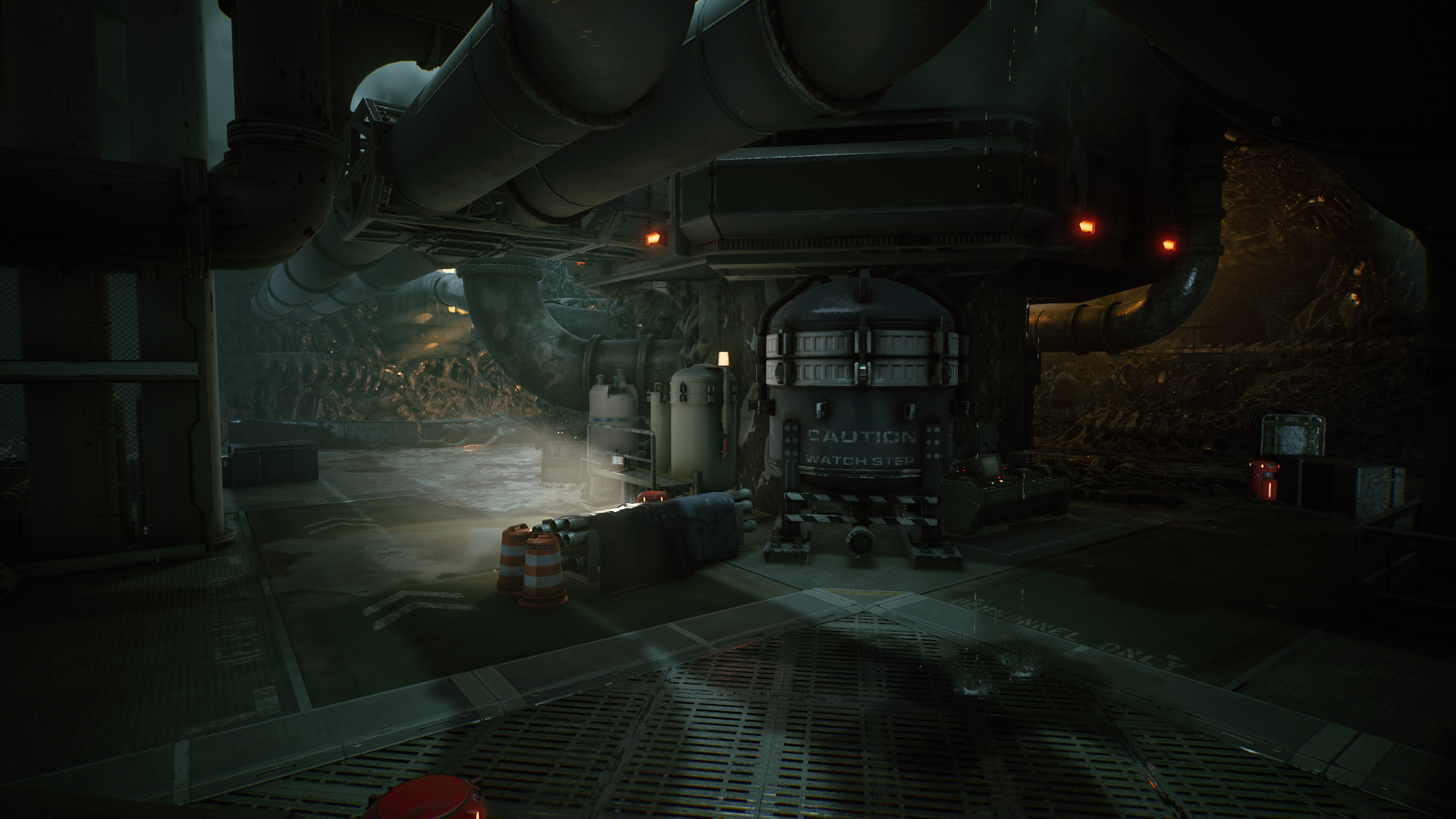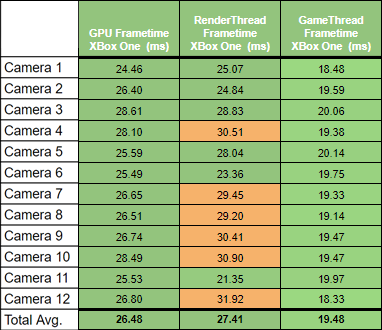Aliens: Fireteam Elite - Ruptured Cistern
1st Art and Lighting Passes
After white boxing, I had planned to start adding functional spawners and gameplay into the level. However, we were directed to focus on art replacement to ensure our white box supported the Industrial (IND) and Hive modular art kits. Our primary goals included:
Full art pass on level architecture using the correct art kits
Resolve any architectural problems integrating the modular kits
First pass lighting
Identifying the Look
I took ownership of ensuring the visual themes of our level closely matched what themes already established throughout the rest of the game, which included:
Familiarizing with both the IND and Hive art kits
Adhering to approved IND and Hive kit assets
Identifying and maintaining established themes and patterns
Ensuring other level artists are kept current
Preparing for the art pass involved many playthroughs of the game’s 1st and 4th Campaigns, to study the use of the IND kit. While using parts of Campaign 4 for Hive kit reference, we primarily used the Horde Mode level Likasi Tower to better familiarize ourselves with kit-bashing the two art sets.
IND kit replacement
Art and Lighting Pass
I began with art tests to establish how the space would look, while maintaining a recognizable Katanga feel. Another artist assisted me with the IND kit, while the Hive tests served as a baseline for another artist who owned the bulk of the Hive sections. l provided direction and feedback, and blended their work into the final level. I served as a subject matter expert for both art kits.
A lot of negative space from the white box was filled in to prevent the player from feeling too small in the large, open areas, and break up the otherwise flat architecture that the majority of the level suffered from.
Throughout the art pass, I also worked closely with our lighting artist to establish lighting themes and colors. Overall, I decided to stick with the cooler colors of the IND kit found in other parts of the game, but I wanted to feel an impact when transitioning to the Hive sections. To achieve this, I opted for highly contrasted warm colors for those areas. Below are some captures from the 1st art and lighting pass:
2nd Art and Lighting Passes
2nd Art Pass and Cleanup
The 2nd art pass occurred concurrently with the design changes following the 1st art pass. This involved an art pass and a cleanup check, focusing primarily on:
Adding props, details, and decals to replace block-ins
Ensuring all cover has proper and contiguous cover functionality
Ensuring assets that need collision have proper collision
Ensuring no art obstructs NavMesh building or enemy pathing
Checking for world holes, assets outside the level, and Z-fighting
Organizing the level Outliner
During the level design iteration, every change was followed by an art cleanup. Since I was responsible for the changes and familiar with the art, I often performed the cleanup myself. We kept strictly to approved assets that had previously been used in IND-dominant levels. Some IND assets and materials were off-limits to us, either for consistency or narrative continuity.
Navmesh edits continued frequently as the art and gameplay evolved. Much of the navmesh was fixed during design passes, but keeping intended pathways free of obstructions remained a high priority for us. Multiple passes were performed to correct and refine collision and cover.
2nd Lighting Pass
Our technical artist began the second lighting pass by fixing technical issues, errors, and performance drops on all lights. I provided assistance with reducing the number of lights and consolidating lights where appropriate.
Overall the major lighting themes and general placements worked well. To really push the experience, however, the entire level saw a complete lighting overhaul with direction and hands on assistance from myself. Every area benefited from additional lighting personality, while enhancing the themes that brought the emotion.
Our entire team was dedicated to elevating the look of the level. Below are some images highlighting some of the prop and lighting work from this stage:
Polish and Performance
Bug Fixing and Polish
After concluding our gameplay changes, Cold Iron’s QA team began providing us with tracked tickets for bugs and other technical issues. I reviewed and documented resolutions for over 100 tickets regarding various types of issues. I also used this time to make any final adjustments and general polish around the level, throughout the art and mission scripting. QA tickets included issues about:
Collision and cover
NavMesh issues
Gameplay bugs
Art errors/requests
Performance Issues
Around the same time, we began receiving late support for standardized performance testing. We were given instruction on setting up performance capture cameras throughout the level, which were used by my team as well as Cold Iron to determine overall performance. Once the team at Cold Iron was able to record a test on their XBox One dev kit, the lowest performing platform that Fireteam Elite was available on at the time, we encountered major concerns.
Our target frame time to achieve a 30 FPS average on XBox One was 27 ms. This needed to be reached in all major gameplay areas where the performance cameras are located. The initial results for Ruptured Cistern showed a significant frame time overage across the GPU and Render Thread, reaching nearly 38 ms in the worst place.
The optimizations were carried out by myself and a developer. Though I primarily focused on resolving QA tickets, I assisted in planning and executing the optimization pass.
Performance numbers before optimizations
Performance Optimizations
Resolving the performance pitfalls took much project research and some conversations with Cold Iron. We compiled and executed upon a set of actions that we determined would yield the most significant results:
Reducing the overall actor count in the level
Reducing the number of assets with 10 or less instances in the level
Removing GPU-intensive VFX
Restricting non-critical sightlines to encourage more occlusion culling
Occluded and obscure assets became quick targets for actor reduction. There was a shift towards actor consolidation in dense areas. With the design iteration completed, many places contained unnecessary art assets that could be replaced with fewer.
By the end of the 2 week process, nearly 1,000 actors and almost all particle-based VFX assets had been removed. Combined with our efforts to increase occlusion culling, we succeeded in bringing down our frame times to within the target range.
Performance numbers after optimizations
Conclusion
Working on Aliens: Fireteam Elite and Ruptured Cistern was an incredible and unforgettable experience. My team produced amazing work while also bringing so much fun and joy to the project. A pivotal moment for myself, my skills, and my mindset, I will be using the lessons learned for a long time to come. I’m incredibly proud of what we’ve produced, and are ecstatic that the A:FE community has enjoyed Ruptured Cistern so much.



















